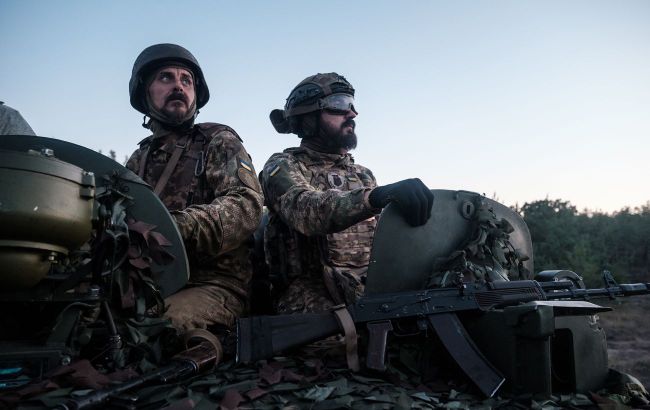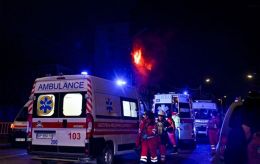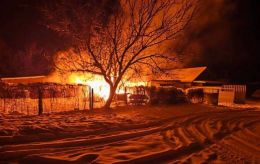Russia's summer strategy: Will enemy launch new offensive and expand the front
 Photo: Battles of varying intensity raging across the front lines (Getty Images)
Photo: Battles of varying intensity raging across the front lines (Getty Images)
After the Russian military advance in the Kharkiv region, which the Ukrainian Armed Forces managed to halt, messages about a supposed threat to the Sumy region began spreading actively. Meanwhile, from the Belarusian side, statements regarding increased tension at the border continue. Simultaneously, the adversary continues to intensify pressure in the Donetsk region.
Details on potential Russian preparations and the possibility of a new offensive are analyzed in the article by RBC-Ukraine below.
Contents
- Possible threat of Russia's advance in the Sumy region
- Statements from Belarus regarding increased tension
- The 'hot' east and Russia's expansion of the front line
Possible threat of Russia's advance in the Sumy region
Rumors of a supposed advance on the Sumy region by Russians began circulating concurrently with increased activity on the northern Kharkiv front, where they did not achieve the results they hoped for. Currently, the Ukrainian State Border Guard Service assures that the Russian military lacks sufficient forces and means to conduct an advance in the Sumy region. A source in the General Staff told RBC-Ukraine that Russia is not currently assembling assault groups near Sumy.
However, border guards spokesperson Andrii Demchenko states that "we must be prepared for any developments as long as Ukraine has a neighbor like Russia." Moreover, he noted a recent decrease in Russian sabotage-reconnaissance group activities.
"Now, over the recent period, we observe a certain reduction in the activity of enemy sabotage-reconnaissance groups, but it has not disappeared entirely. And the threat from enemy sabotage activities remains," Demchenko said during a telethon.
However, border guards do not rule out that Russia may expand the zone of active combat operations. Analysts of the American Institute for the Study of War (ISW) state that it is currently unclear whether there will be a new Russian advance. However, in such a scenario, analysts assess that any enemy offensive actions would aim to press and divert Ukrainian forces from other critical sections of the front line.
According to military expert Pavlo Narozhnyy, currently, the occupation forces do not have the resources to advance in the Sumy region. Moreover, the Russians have already stretched the front line into the Kharkiv region, where they are successfully holding positions.
"They (Russians - Ed.) are attempting to advance there, but it looks more like they are attempting to repel Ukrainian counterattacks. That's the maximum they can do there right now. They are in such a quandary because they cannot advance in the Kharkiv region, and there is nowhere to retreat. There are no prepared positions to retreat to. So, they are in such a 'cul-de-sac'. Somewhere there, they are encircled near the Aggregate Plant, which they are also not willing to abandon, let's put it that way," the interlocutor noted.
The expert explains that for a Russian advance, tens of thousands of soldiers are needed, for example, in the Kharkiv region, where the enemy has gathered a contingent of approximately 90,000.
"That is, they (Russia - Ed.) need at least 60-70 thousand in the Sumy region, and they simply do not have them. Because now they mobilize 30-32 thousand per month, which is enough to cover losses in the war in Ukraine," Narozhnyy said.
Statements from Belarus regarding increased tension
Recently, the regime of Alexander Lukashenko began disseminating statements, allegedly about increased tension on the border with Ukraine. Belarusian generals again claim a so-called deployment of forces to the border with Ukraine, and in addition to previous threats, nuclear ones were added.
For example, yesterday Lukashenko claimed that Belarusian border guards have been put on enhanced border security, Special Operations Forces have been deployed, and air defense and missile defense forces have been brought to high combat readiness. Meanwhile, Ukrainian border guards call Belarusian statements solely manipulations and informational throw-ins aimed at shifting responsibility onto Ukraine.
"The Belarusian direction will remain threatening for us as long as Belarus remains in Russia's sphere of influence. And we will continue to build up our defensive capabilities," Demchenko noted.
Moreover, there are no grounds for the direct involvement of the Belarusian army in the war. As pointed out by expert Pavlo Narozhnyy, Belarus lacks resources, motivation, and capabilities.
"Who will fight on the Belarusian side? The Belarusian army? Which handed over all its weapons to Russia, which has miserable 3-4 battalions and motivation below the floorboards. Simply put, what sense is there for them to fight? All they can do is psychological attacks. Some tensions there, or send migrants to Europe. That's all they are capable of," Narozhnyy says.
The 'hot' east and Russia's expansion of the front line
According to Commander-in-Chief of the Armed Forces of Ukraine Oleksandr Syrskyi, currently, fierce battles of varying intensity continue along the entire front line, with a complex situation remaining in the Pokrovsk direction. Compared to two weeks ago, the Toretsk direction has also been added, where Ukrainian soldiers significantly reduce the number of attacking enemy forces every day. In other directions, the intensity of combat has decreased, but the line of the active front has expanded.
In a conversation, expert Pavlo Narozhnyy explains that it is unlikely that the Russians will be able to stretch new directions and will primarily focus their efforts on improving the tactical situation.
"These are Pokrovsk, Toretsk directions, and Chasiv Yar, which they (Russian army - Ed.) cannot storm head-on, but will attempt flanking maneuvers. Perhaps some attempts will be made in the Kupiansk direction. But now everything looks like the Toretsk and Pokrovsk directions are the main ones for their advance. This is what they have been talking about since the beginning of their summer campaign," Narozhnyy says.
He explains that currently, the task for the occupiers is to reach the borders of the Donetsk region and occupy the Kramatorsk-Sloviansk agglomeration. And so far, the enemy has had tactical successes in the Pokrovsk direction, where they have advanced to Ocheretyne, but now the Ukrainian army is counterattacking there fairly successfully.
"That is, it looks like the summer campaign of the Russians has successfully bogged down. They do not have any serious successes, and they have huge losses, especially in the Kharkiv direction. Where there is simply a 'black hole'. Where Vovchansk, where they send soldiers, and they are destroyed there. Where Ukrainian artillery has been unleashed and is operating in the Belgorod region, in their rear, and so on," the expert summed up.
Earlier RBC-Ukraine wrote about the situation on the front line and what will help Ukrainian soldiers thwart the enemy's advance.
We also reported on why the occupiers targeted Toretsk and what their goal is.
Sources: ISW analysts' report, data from the Center for Strategic Communications and Information Security, statements by Ukrainian State Border Guard Service spokesperson Andrii Demchenko, Commander-in-Chief Oleksandr Syrskyi, exclusive comment by military expert Pavlo Narozhnyy.

